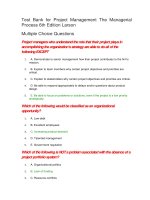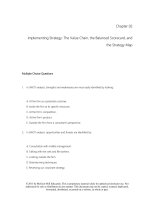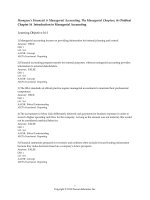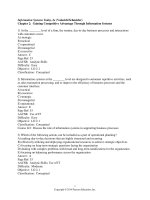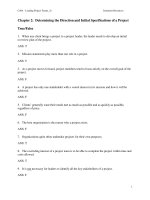Project management the managerial process 6th edition larson test bank
Bạn đang xem bản rút gọn của tài liệu. Xem và tải ngay bản đầy đủ của tài liệu tại đây (351.95 KB, 64 trang )
Chapter 02
Organization Strategy and Project Selection
Multiple Choice Questions
1.
Which of the following is NOT true about an organization's strategy?
A. Strategy determines how an organization will compete
B. Strategy is implemented through projects
C. Only top management must understand strategy
D. Project selection should be clearly aligned with strategy
E. Project management plays a key role in supporting strategy
2.
A project selection process that is strongly linked to strategy results in
A. The most profit.
B. Better utilization of the organization's resources.
C. More projects.
D. A larger and more diverse organization.
E. Stronger core competencies.
3.
Which of the following is NOT true about organizational politics?
A. Project managers should not engage in organizational politics
B. Politics can have a significant influence on which projects receive funding
C. Politics exist in every organization
D. Politics can influence project selection
E. Politics can play a role in the aspirations behind projects
2-1
Copyright © 2014 McGraw-Hill Education. All rights reserved. No reproduction or distribution without the prior written consent of
McGraw-Hill Education.
4.
Which of the following terms is often used to denote a project that a powerful, high-ranking official
is advocating?
A. Sacred cow
B. Pet project
C. Political necessity
D. Special undertaking
E. Strategic ploy
5.
Why do project managers need to understand their organization's mission and strategy?
A. To reduce project duration and increase the number of projects implemented
B. So they can make appropriate decisions and adjustments and be effective project advocates
C. It is only important for senior management to understand the organization's mission and
strategy
D. To get their job done and increase opportunities for promotion
E. So that they can make sure the customer is satisfied
6.
Project managers who understand the role that their project plays in accomplishing the
organization's strategy are able to do all of the following EXCEPT
A. Demonstrate to senior management how their project contributes to the firm's mission.
B. Explain to team members why certain project objectives and priorities are critical.
C. Explain to stakeholders why certain project objectives and priorities are critical.
D. Be able to respond appropriately to delays and/or questions about product design.
E. Be able to focus on problems or solutions, even if the project is a low priority strategically.
2-2
Copyright © 2014 McGraw-Hill Education. All rights reserved. No reproduction or distribution without the prior written consent of
McGraw-Hill Education.
7.
All of the following are symptoms of organizations struggling with strategy disconnect and unclear
priorities EXCEPT
A. Frequent conflicts between managers.
B. Inadequate resources.
C. Confused employees regarding which projects are more important.
D. Not enough projects within the portfolio to make a profit.
E. People are working on multiple projects and feel inefficient.
8.
Which of the following problems refers to lack of understanding and consensus of organization
strategy among top and middle-level managers? This also can result when top management
formulates strategy and leaves implementation to functional managers.
A. Multitasking
B. Organization politics
C. Implementation gap
D. Resource conflicts
E. Employee turnover
9.
Which of the following is NOT true for strategic management?
A. It should be done once every few years just before developing the operating plan
B. It supports consistency of action at every level of the organization
C. It develops an integrated and coordinated long-term plan of action
D. It positions the firm to meet the needs of its customers
E. It involves responding to changes in the external market and allocating scarce resources to
improve a competitive position
2-3
Copyright © 2014 McGraw-Hill Education. All rights reserved. No reproduction or distribution without the prior written consent of
McGraw-Hill Education.
10. Which of the following is the correct order for the strategic management process?
A. Strategies, mission, objectives, projects
B. Objectives, projects, mission, strategies
C. Mission, strategies, objectives, projects
D. Objectives, mission, strategies, projects
E. Projects, mission, strategies, objectives
11. Which of the following questions does the organization's mission statement answer?
A. What are our long-term strategies?
B. What are our long-term goals and objectives?
C. How do we operate in the existing environment?
D. What do we want to become?
E. All of these are answered by the mission statement
12. Which of the following is NOT one of the traditional components found in mission statements?
A. Major products and services
B. Profitability
C. Target customers and markets
D. Geographic domain
E. Contribution to society
13. Which of the following is NOT one of the characteristics of effective objectives?
A. Realistic
B. Assignable
C. Flexible
D. Specific
E. Measurable
2-4
Copyright © 2014 McGraw-Hill Education. All rights reserved. No reproduction or distribution without the prior written consent of
McGraw-Hill Education.
14. In order to formulate strategies that align with the mission the organization will need to
A. Assess internal strengths and weaknesses.
B. Analyze competitors.
C. Examine the external environment.
D. Know their core competencies.
E. All of these should be considered when formulating strategies.
15. The assessment of the external and internal environments is called _______ analysis.
A. SWOT
B. Competitive
C. Industry
D. Market
E. Strategic
16. Which of the following would be classified as an organizational threat?
A. Slowing of the economy
B. Excellent employees
C. Poor product quality
D. Declining facilities
E. High labor costs
17. Which of the following would be classified as an organizational opportunity?
A. Low debt
B. Excellent employees
C. Increasing product demand
D. Talented management
E. Government regulation
2-5
Copyright © 2014 McGraw-Hill Education. All rights reserved. No reproduction or distribution without the prior written consent of
McGraw-Hill Education.
18. Which of the following is NOT one of the requirements for successful implementation of strategies
through projects?
A. Allocation of resources
B. Prioritizing of projects
C. Motivation of project contributors
D. Adequate planning and control systems
E. Quality management
19. Which of the following is NOT a problem associated with the absence of a project portfolio
system?
A. Organizational politics
B. Lack of funding
C. Resource conflicts
D. Multitasking
E. Implementation gap
20. Susie's department is implementing many projects. She finds herself starting and stopping work on
one task to go and work on another task, and then return to the work on the original task. Susie is
experiencing
A. Poor scheduling.
B. Excess work burden.
C. Flexible tasking.
D. Multitasking.
E. Burnout.
2-6
Copyright © 2014 McGraw-Hill Education. All rights reserved. No reproduction or distribution without the prior written consent of
McGraw-Hill Education.
21. Project selection criteria are typically classified as
A. Financial and nonfinancial.
B. Short-term and long-term.
C. Strategic and tactical.
D. Required and optional.
E. Cost and schedule.
22. The __________ financial model measures the current value of all cash inflows using management's
minimum desired rate of return.
A. FUBAR
B. ARR
C. IRS
D. IRB
E. None of these
23. Projects are usually classified into all but one of the following categories. Which one is NOT one of
the typical classifications?
A. Compliance and emergency
B. Operational
C. Strategic
D. Political necessity
E. All of these are typical classifications
2-7
Copyright © 2014 McGraw-Hill Education. All rights reserved. No reproduction or distribution without the prior written consent of
McGraw-Hill Education.
24. One who endorses and lends political support for the completion of a specific project is known as
the
A. Project manager.
B. CEO.
C. Project sponsor.
D. Project lead.
E. Sacred cow.
25. A project screening matrix typically contains all of the following EXCEPT
A. The list of available projects
B. Specific criteria
C. Weights assigned to specific criteria
D. Costs to complete each project
E. All of these are typically contained
26. Regardless of the criteria differences among different types of projects, the most important criterion
for project selection is
A. How the project will balance risk within the project portfolio
B. The project's fit to the organization strategy
C. Compliance
D. Nonfinancial
E. Profit
2-8
Copyright © 2014 McGraw-Hill Education. All rights reserved. No reproduction or distribution without the prior written consent of
McGraw-Hill Education.
27. Examples of nonfinancial criteria include all of the following EXCEPT
A. Capturing a larger market share.
B. Reducing dependency on unreliable suppliers.
C. Preventing government intervention and regulation.
D. Making it difficult for competitors to enter the market.
E. Calculating the time it will take to recover the project investment.
28. Which of the following is true of multiweighted scoring models?
A. Will include quantitative criteria
B. Will include qualitative criteria
C. Each criterion is assigned a weight
D. Projects with higher scores are considered more desirable
E. All of these are true
29. Which of the following is NOT true when managing a portfolio system?
A. The qualities of a particular project are assessed within the context of existing projects
B. It does not require a constant effort
C. Within a small organization it can be managed by a small group of key employees
D. It requires input from senior management
E. It involves monitoring and adjusting criteria to reflect the strategic focus of the organization
2-9
Copyright © 2014 McGraw-Hill Education. All rights reserved. No reproduction or distribution without the prior written consent of
McGraw-Hill Education.
30. The following are responsibilities of the governance team when managing a portfolio system
EXCEPT
A. Deciding how they wish to balance the available organizational resources among the different
types of projects.
B. Publishing the priority of every project and ensuring the process is open and free of power
politics.
C. Evaluating the progress of the projects in the portfolio.
D. Constant scanning of the external environment to determine if organizational selection criteria
need to be changed.
E. Communicating which projects are approved.
Fill in the Blank Questions
31. The process of assessing "what we are" and deciding and implementing "what we intend to be and
how we are going to get there" is ______________.
________________________________________
32. ________ change infrequently and may require revision only when the nature of the business
changes or shifts.
________________________________________
33. ________ translate the organization's strategy into specific, concrete, and measurable terms.
________________________________________
34. How strategies will be realized, given available resources, is answered through __________.
________________________________________
2-10
Copyright © 2014 McGraw-Hill Education. All rights reserved. No reproduction or distribution without the prior written consent of
McGraw-Hill Education.
35. High-ranking managers who endorse and lend political support for the completion of a specific
project are known as project _________.
________________________________________
36. A weighted scoring model typically uses several weighted selection criteria to evaluate project
proposals. An example of this would be a(n) ____________.
________________________________________
37. What the organization wants to become and the scope of the firm in terms of its product or service
would be identified in the organization's ____________.
________________________________________
38. In a SWOT analysis, good product quality, low debt, and an established supplier network are
examples of internal ________.
________________________________________
39. In a SWOT analysis, strong competition, reduced product demand, and a maturing product life
cycle are examples of external __________.
________________________________________
40. The assessment of the internal and external environments is known as a(n) ________.
________________________________________
41. Strategy is implemented through ________.
________________________________________
42. A project that a powerful, high-ranking official is advocating is often termed a(n) ___________.
________________________________________
2-11
Copyright © 2014 McGraw-Hill Education. All rights reserved. No reproduction or distribution without the prior written consent of
McGraw-Hill Education.
43. Starting and stopping work on one task to go and work on another project, and then returning to
work on the original task is known as ___________.
________________________________________
44. The lack of understanding and consensus of organization strategy among top and middle-level
managers is known as the __________.
________________________________________
45. The financial model that measures the time it will take to recover the project investment is the
__________ model.
________________________________________
46. The financial model that measures the current value of all cash inflows and outflows using
management's minimum desired rate of return is known as the _________ model.
________________________________________
47. In classifying the kinds of projects an organization has in its portfolio, projects that are typically
those needed to meet regulatory conditions required to operate in a region are ___________
projects.
________________________________________
48. In classifying the kinds of projects an organization has in its portfolio, projects that are typically
needed to support current operations are _________ projects.
________________________________________
49. In classifying the kinds of projects an organization has in its portfolio, projects that directly support
the organization's long-term mission are ________ projects.
________________________________________
2-12
Copyright © 2014 McGraw-Hill Education. All rights reserved. No reproduction or distribution without the prior written consent of
McGraw-Hill Education.
50. When considering criteria used to select projects, capturing a larger market share or reducing the
dependency on unreliable suppliers would both be examples of __________ criteria.
________________________________________
51. In some cases organizations will use a(n) __________ to solicit ideas for projects when the knowledge
requirements for the project are not available in the organization.
________________________________________
52. A list of potential projects, several criteria, weights for those criteria, and criteria scores for those
projects are all typically included on a(n) ___________ matrix.
________________________________________
53. __________ the portfolio system involves monitoring and adjusting selection criteria to reflect the
strategic focus of the organization.
________________________________________
True / False Questions
54. Project management historically has been preoccupied solely with the planning and execution of
projects while strategy was under the purview of senior management.
True
False
55. Intermittent scanning of the external environment is required when managing organization
strategy.
True
False
2-13
Copyright © 2014 McGraw-Hill Education. All rights reserved. No reproduction or distribution without the prior written consent of
McGraw-Hill Education.
56. A written mission statement provides focus for decision making when shared by organizational
managers and employees.
True
False
57. Project managers should not engage in organizational politics.
True
False
58. Organizational objectives set targets for all levels of the organization not just for top management.
True
False
59. Mission statements typically change frequently, responding to changes in the external
environment.
True
False
60. Strategy formulation ends with cascading objectives or projects assigned to lower divisions,
departments, or individuals.
True
False
61. If a proposed project does not meet one of the designated "must" objectives it is immediately
removed from consideration.
True
False
62. The assessment of the external and internal environments is called the SWOT analysis.
True
False
63. Objectives should be specific, marketable, assignable, realistic, and time related.
True
False
2-14
Copyright © 2014 McGraw-Hill Education. All rights reserved. No reproduction or distribution without the prior written consent of
McGraw-Hill Education.
64. Strategy is implemented through projects.
True
False
65. Many organizations have three different kinds of projects in their portfolio: compliance, operational,
and sacred cows.
True
False
66. The first step in the Strategic Management Process is to set long-range goals and objectives.
True
False
67. One benefit of project portfolio management is that it can justify killing a project that doesn't
support organization strategy.
True
False
68. Opportunities and threats can be viewed as flip sides of each other; that is, a threat can be viewed
as an opportunity, and vice versa.
True
False
69. The information gap refers to the lack of understanding and consensus of organization strategy
among top and middle-level managers.
True
False
70. One way to offset the influence of politics on project management within an organization is to have
a well-defined project selection model.
True
False
71. Studies have shown that companies using predominantly financial criteria to prioritize projects yield
unbalanced portfolios and projects that aren't strategically aligned.
True
False
2-15
Copyright © 2014 McGraw-Hill Education. All rights reserved. No reproduction or distribution without the prior written consent of
McGraw-Hill Education.
72. Generally, people working on several projects at the same time are more efficient than people
working full-time on one project.
True
False
73. The NPV financial model measures the time it will take to recover the project investment.
True
False
74. A proposed project that ranks high on most criteria may not be selected because the organization's
portfolio already includes too many projects with the same characteristics.
True
False
75. Multiweighted scoring models include only quantitative criteria, not qualitative.
True
False
Short Answer Questions
76. "Politics and project management should not mix." Agree or disagree and support your position.
2-16
Copyright © 2014 McGraw-Hill Education. All rights reserved. No reproduction or distribution without the prior written consent of
McGraw-Hill Education.
77. Why do project managers need to understand strategy?
78. Why is it important that organizations develop a process to align selected projects with strategic
goals?
79. The typical Strategic Management Process includes four activities. Identify and briefly describe each
of those four activities.
2-17
Copyright © 2014 McGraw-Hill Education. All rights reserved. No reproduction or distribution without the prior written consent of
McGraw-Hill Education.
80. The advantages of successful project portfolio management systems are becoming well recognized.
Briefly describe three.
81. Identify and briefly describe the five characteristics of effective objectives.
82. What is a SWOT analysis and how does it relate to the Strategic Management Process?
2-18
Copyright © 2014 McGraw-Hill Education. All rights reserved. No reproduction or distribution without the prior written consent of
McGraw-Hill Education.
83. What is the implementation gap and how does it impact project management? How can it be
prevented?
84. Identify and briefly discuss the three classes of projects usually found in an organization's project
portfolio.
85. Management of a portfolio system requires two major inputs from senior management. What are
they?
2-19
Copyright © 2014 McGraw-Hill Education. All rights reserved. No reproduction or distribution without the prior written consent of
McGraw-Hill Education.
86. Why is profitability alone not an adequate measure of a project's value to an organization?
87. What are the two major shortcomings of using the Checklist approach to select projects?
2-20
Copyright © 2014 McGraw-Hill Education. All rights reserved. No reproduction or distribution without the prior written consent of
McGraw-Hill Education.
Chapter 02 Organization Strategy and Project Selection Answer Key
Multiple Choice Questions
1.
Which of the following is NOT true about an organization's strategy?
A. Strategy determines how an organization will compete
B. Strategy is implemented through projects
C. Only top management must understand strategy
D. Project selection should be clearly aligned with strategy
E. Project management plays a key role in supporting strategy
Strategy was considered to be under the purview of senior management, but this is old school
thinking. Projects and project management play a key role in supporting strategic goals. It is vital
for project managers to think and act strategically.
AACSB: Reflective Thinking
Accessibility: Keyboard Navigation
Blooms: Understand
Learning Objective: The Strategic Management Process: An Overview
Level of Difficulty: 2 Medium
2-21
Copyright © 2014 McGraw-Hill Education. All rights reserved. No reproduction or distribution without the prior written consent of
McGraw-Hill Education.
2.
A project selection process that is strongly linked to strategy results in
A. The most profit.
B. Better utilization of the organization's resources.
C. More projects.
D. A larger and more diverse organization.
E. Stronger core competencies.
Without integration of projects with the strategic plan, resources are poorly utilized. Conversely,
organizations that have a link of projects to strategy have more cooperation across the
organization, perform better on projects and tend to have fewer projects.
AACSB: Reflective Thinking
Accessibility: Keyboard Navigation
Blooms: Understand
Learning Objective: The Strategic Management Process: An Overview
Level of Difficulty: 2 Medium
3.
Which of the following is NOT true about organizational politics?
A. Project managers should not engage in organizational politics
B. Politics can have a significant influence on which projects receive funding
C. Politics exist in every organization
D. Politics can influence project selection
E. Politics can play a role in the aspirations behind projects
Many would argue that project management and politics should not mix. A more proactive
response would be that projects and politics invariably mix. Effective project managers recognize
that any significant project has political ramifications.
AACSB: Reflective Thinking
Accessibility: Keyboard Navigation
Blooms: Understand
Learning Objective: The Need for a Project Portfolio Management System
Level of Difficulty: 3 Hard
2-22
Copyright © 2014 McGraw-Hill Education. All rights reserved. No reproduction or distribution without the prior written consent of
McGraw-Hill Education.
4.
Which of the following terms is often used to denote a project that a powerful, high-ranking
official is advocating?
A. Sacred cow
B. Pet project
C. Political necessity
D. Special undertaking
E. Strategic ploy
The term "sacred cow" is often used to denote a project that a powerful, high-ranking official is
advocating.
AACSB: Reflective Thinking
Accessibility: Keyboard Navigation
Blooms: Remember
Learning Objective: The Need for a Project Portfolio Management System
Level of Difficulty: 1 Easy
2-23
Copyright © 2014 McGraw-Hill Education. All rights reserved. No reproduction or distribution without the prior written consent of
McGraw-Hill Education.
5.
Why do project managers need to understand their organization's mission and strategy?
A. To reduce project duration and increase the number of projects implemented
B. So they can make appropriate decisions and adjustments and be effective project advocates
C. It is only important for senior management to understand the organization's mission and
strategy
D. To get their job done and increase opportunities for promotion
E. So that they can make sure the customer is satisfied
There are two main reasons why project managers need to understand their organization's
mission and strategy. The first reason is so they can make appropriate decisions and
adjustments. For example, how a project manager would respond to a suggestion to modify the
design of a product to enhance performance will vary depending upon whether his company
strives to be a product leader through innovation or to achieve operational excellence through
low cost solutions. The second reason project managers need to understand their organization's
strategy is so that they can be effective project advocates. Project managers have to be able to
demonstrate to senior management how their project contributes to their firm's mission.
AACSB: Reflective Thinking
Accessibility: Keyboard Navigation
Blooms: Understand
Learning Objective: The Strategic Management Process: An Overview
Level of Difficulty: 1 Easy
2-24
Copyright © 2014 McGraw-Hill Education. All rights reserved. No reproduction or distribution without the prior written consent of
McGraw-Hill Education.
6.
Project managers who understand the role that their project plays in accomplishing the
organization's strategy are able to do all of the following EXCEPT
A. Demonstrate to senior management how their project contributes to the firm's mission.
B. Explain to team members why certain project objectives and priorities are critical.
C. Explain to stakeholders why certain project objectives and priorities are critical.
D. Be able to respond appropriately to delays and/or questions about product design.
E. Be able to focus on problems or solutions, even if the project is a low priority strategically.
Project managers who understand the role that their project plays in accomplishing the
organization's strategy will not be inclined to waste time focusing on problems that are a low
priority in regard to achieving the organization's strategy.
AACSB: Reflective Thinking
Accessibility: Keyboard Navigation
Blooms: Understand
Learning Objective: The Strategic Management Process: An Overview
Level of Difficulty: 2 Medium
7.
All of the following are symptoms of organizations struggling with strategy disconnect and
unclear priorities EXCEPT
A. Frequent conflicts between managers.
B. Inadequate resources.
C. Confused employees regarding which projects are more important.
D. Not enough projects within the portfolio to make a profit.
E. People are working on multiple projects and feel inefficient.
Frequent conflicts between managers, inadequate resources, confused employees and
multitasking are all symptoms of organizations struggling with strategy disconnect and unclear
priorities. Typically these organizations are also completing projects with low priority which
results in a portfolio that consists of too many projects that do not align with organizational
strategy.
AACSB: Reflective Thinking
2-25
Copyright © 2014 McGraw-Hill Education. All rights reserved. No reproduction or distribution without the prior written consent of
McGraw-Hill Education.

